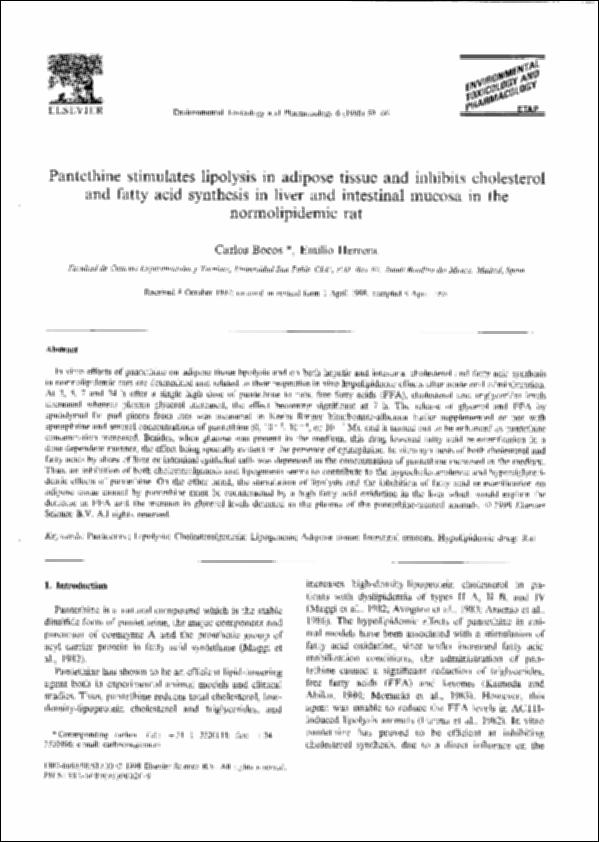Please use this identifier to cite or link to this item:
http://hdl.handle.net/10637/1080Pantethine stimulates lipolysis in adipose tissue and inhibits cholesterol and fatty acid synthesis in liver and intestinal mucosa in the normolipidemic rat.
| Title: | Pantethine stimulates lipolysis in adipose tissue and inhibits cholesterol and fatty acid synthesis in liver and intestinal mucosa in the normolipidemic rat. |
| Authors : | Bocos de Prada, Carlos Herrera Castillón, Emilio. |
| Keywords: | Pantethine; Lipolysis; Cholesterolgenesis; Lipogenesis; Adipose tissue; Intestinal mucosa; Hypolipidemic drug; Rat |
| Abstract: | In vitro effects of pantethine on adipose tissue lipolysis and on both hepatic and intestinal cholesterol and fatty acid synthesis in normolipidemic rats are determined and related to their respective in vivo hypolipidemic effects after acute oral administration. At 3, 5, 7 and 24 h after a single high dose of pantethine to rats, free fatty acids (FFA), cholesterol and triglycerides levels decreased whereas plasma glycerol increased, the effect becoming significant at 7 h. The release of glycerol and FF A by epididymal fat pad pieces from rats was measured in Krebs Ringer bicarbonate-albumin buffer supplemented or not with epinephrine and several concentrations of pantethine (0, 10 - 5 , 10 -4, or 10 - 3 M), and it turned out to be enhanced as pantethine concentration increased. Besides, when glucose was present in the medium, this drug lowered fatty acid re-esterification in a dose-dependent manner, the effect being specially evident in the presence of epinephrine. In vitro synthesis of both cholesterol and fatty acids by slices of liver or intestinal epithelial cells was depressed as the concentration of pantethine increased in the medium. Thus, an inhibition of both cholesterolgenesis and lipogenesis seems to contribute to the hypocholesterolemic and hypotriglyceridemic effects of pantethine. On the other hand, the stimulation of lipolysis and the inhibition of fatty acid re-esterification on adipose tissue caused by pantethine must be counteracted by a high fatty acid oxidation in the liver which would explain the decrease in FF A and the increase in glycerol levels detected in the plasma of the pantethine-treated animals. © 1998 Elsevier Science B.V. All rights reserved. |
| Description: | En: Environmental toxicology and pharmacology. 1998. n. 6 : 59-66 p. 1382-6689 |
| URI: | http://hdl.handle.net/10637/1080 |
| Rights : | http://creativecommons.org/licenses/by-nc-nd/4.0/deed.es |
| Issue Date: | 19-Sep-1998 |
| Center : | Universidad San Pablo-CEU |
| Appears in Collections: | Facultad de Farmacia |
Items in DSpace are protected by copyright, with all rights reserved, unless otherwise indicated.


